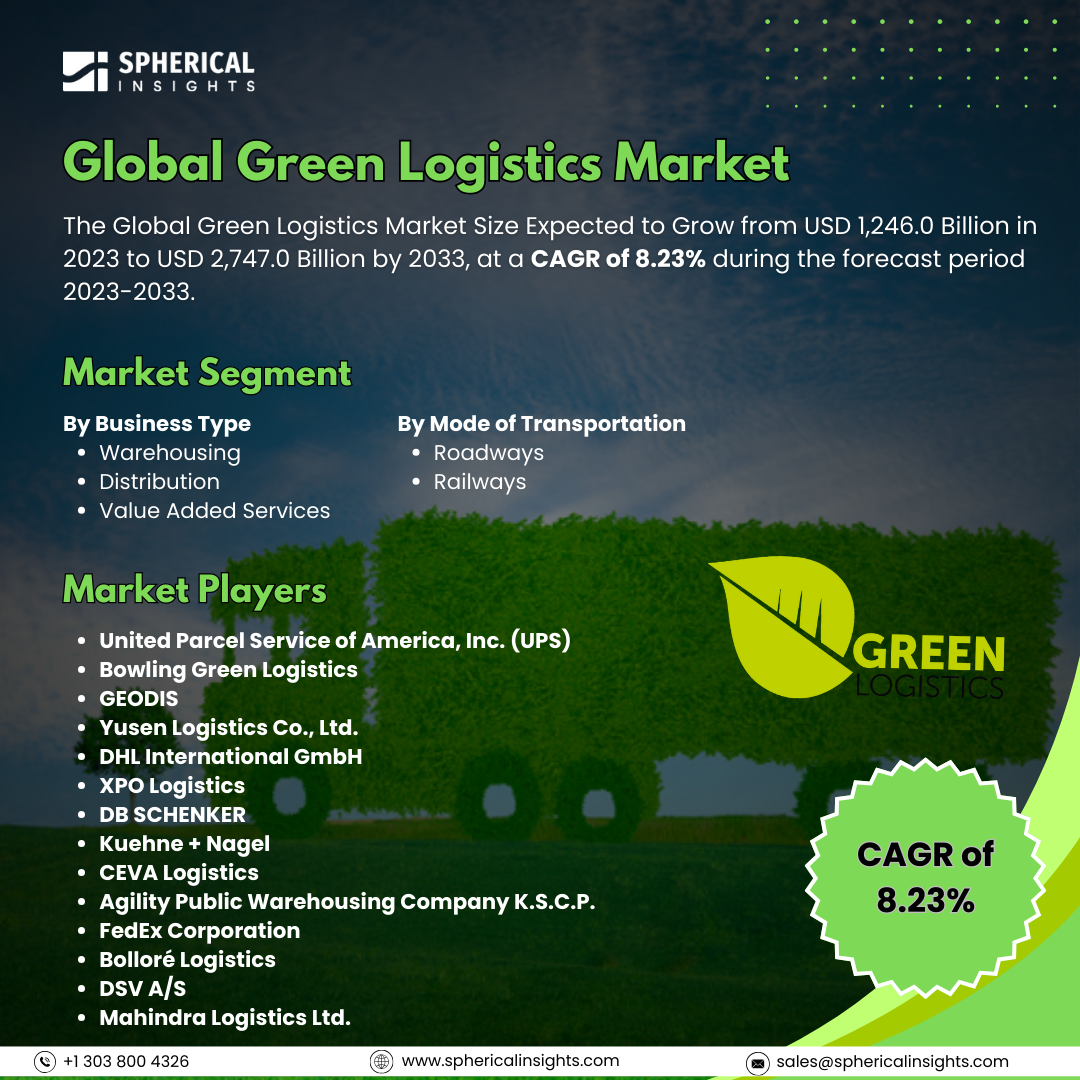Global Green Logistics Market Size to Exceed USD 2,747.0 Billion by 2033
According to a research report published by Spherical Insights & Consulting, The Global Green Logistics Market Size Expected to Grow from USD 1,246.0 Billion in 2023 to USD 2,747.0 Billion by 2033, at a CAGR of 8.23% during the forecast period 2023-2033.
Browse 210 market data Tables and 45 Figures spread through 190 Pages and in-depth TOC on the Global Green Logistics Market Size, Share, and COVID-19 Impact Analysis, By Business Type (Warehousing, Distribution, and Value-Added Services), By Mode of Transportation (Roadways and Railways), and By Region (North America, Europe, Asia Pacific, Latin America, Middle East, and Africa), Analysis and Forecast 2023 – 2033
Green logistics market is a company committed to designing and implementing ecologically sound approaches to supply chain and logistics processes. It encompasses methods, technology, and services that reduce logistics processes' environmental impact, such as transportation, warehousing, packaging, and distribution while remaining efficient and cost-effective. Moreover, the green logistics market is driven by growing environmental regulations, business sustainability initiatives, and growing customer demand for sustainable operations. Technological progress in alternative fuel technologies, electric vehicles, and renewable energy technologies fuels adoption. Energy-saving advantages of optimized operations and minimized logistics fuel growth further. Government incentives, carbon neutrality mandates, and differentiation requirements also prompt companies to implement green logistics solutions. However, the green logistics market is hindered by factors like high investment, low alternative fuel infrastructure, technology problems, and resistance towards change from traditional logistics practices, particularly in price-sensitive industries.
The distribution segment accounted for the largest share of the global green logistics market in 2023 and is anticipated to grow at a significant CAGR during the forecast period.
On the basis of business type, the global green logistics market is divided into warehousing, distribution, and value-added services. Among these, the distribution segment accounted for the largest share of the global green logistics market in 2023 and is anticipated to grow at a significant CAGR during the forecast period. This is because transport is an essential part of supply chains, with sustainable choices like electric vehicles, route optimization, and fuel-saving technologies reducing emissions and costs significantly, aligned with sustainability goals and regulatory requirements of industries across the globe.
The roadways segment accounted for a substantial share of the global green logistics market in 2023 and is anticipated to grow at a rapid pace during the projected period.
Based on the mode of transportation, the global green logistics market is divided into roadways and railways. Among these, the roadways segment accounted for a substantial share of the global green logistics market in 2023 and is anticipated to grow at a rapid pace during the projected period. They are lightweight, have high energy density, longer lifespan, and quick charging. This is due to their flexibility, extensive network, and dominance in last-mile delivery. Green innovations like electric trucks, alternative fuels, and route optimization have further enhanced their sustainability, making roadways a preferred choice for environmentally conscious logistics operations across industries.
Europe is projected to hold the largest share of the global green logistics market over the projected period.
Europe is projected to hold the largest share of the global green logistics market over the projected period. This is due to strict environmental regulations, such as the EU Green Deal, and strong government incentives promoting sustainable practices. High adoption of electric vehicles, renewable energy in warehousing, and robust rail and road infrastructure drive growth. Additionally, increasing consumer demand for eco-friendly supply chains supports market expansion in the region.
Asia Pacific is expected to grow at the fastest CAGR growth of the global green logistics market during the projected period. The region's accelerated market growth can be attributed to the increasing demand for e-commerce as well as the growing concern for environmental sustainability. The surge in industrial production, combined with urbanization and government efforts towards sustainable development, is the primary reason for so much investment in the region by China, Japan, and India. These nations are pouring their resources into electric automobiles, renewable energy sources, and environmentally friendly supply chain measures.
Company Profiling
Major vendors in the global green logistics market are United Parcel Service, Bowling Green Logistics, GEODIS, Yusen Logistics Co., Ltd, DHL International GmbH, XPO Logistics, DB SCHENKER, Kuehne + Nagel, CEVA Logistics, Agility Public Warehousing Company K.S.C.P., and Others.
Key Target Audience
- Market Players
- Investors
- End-users
- Government Authorities
- Consulting and Research Firm
- Venture capitalists
- Value-Added Resellers (VARs)
Recent Development
- In November 2024, the FORPLANET suite, which consists of low-carbon transport solutions and encourages circular economy practices such as closed-loop supply chains, was developed to reduce global carbon emissions. In support of decarbonization efforts, CEVA Logistics launched the FORPLANET sub-brand alongside the main brand suite, intending to replace standard fuels, shift vehicle modes, or introduce electric vehicles.
Market Segment
This study forecasts revenue at global, regional, and country levels from 2023 to 2033. Spherical Insights has segmented the global green logistics market based on the below-mentioned segments:
Global Green Logistics Market, By Business Type
- Warehousing
- Distribution
- Value Added Services
Global Green Logistics Market, By Mode of Transportation
Global Green Logistics Market, By Regional
- North America
- Europe
- Germany
- UK
- France
- Italy
- Spain
- Russia
- Rest of Europe
- Asia Pacific
- China
- Japan
- India
- South Korea
- Australia
- Rest of Asia Pacific
- South America
- Brazil
- Argentina
- Rest of South America
- Middle East & Africa
- UAE
- Saudi Arabia
- Qatar
- South Africa
- Rest of the Middle East & Africa



